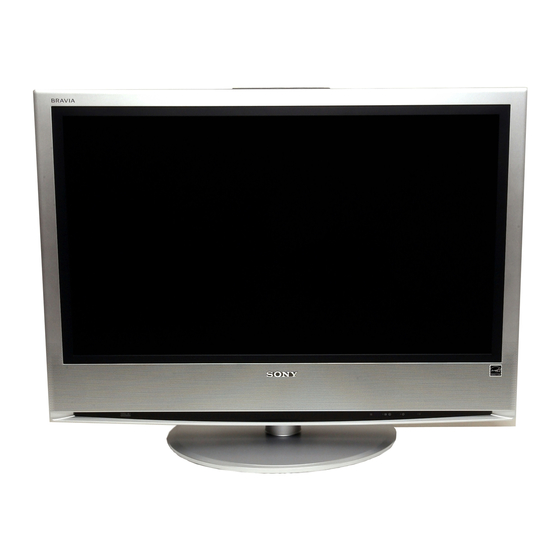Table of Contents

Summarization of Contents
Safety Precautions
AC Power Cord Safety
Precautions for handling and using the AC power cord to prevent electrical hazards.
Installation and Placement Safety
Guidelines for safe TV installation and placement to avoid damage or injury.
Handling and Usage Warnings
Warnings about water, moisture, carrying, and other handling aspects to ensure safety.
Remote Control Operations
Power, Input, and Channel Controls
Functions of buttons for TV power, standby, input source selection, and channel navigation.
Volume and Special Function Buttons
Using buttons to adjust volume, access WEGA GATE, Picture Freeze, and sound/picture modes.
TV Buttons and Indicator Lights
On-TV Control Panel Functions
Description of the TV's onboard buttons for power, channel, volume, and input selection.
Understanding Status Indicator Lights
Explanation of the meaning of the TV's standby and power indicator lights.
Introducing WEGA GATE
What is WEGA GATE?
Overview of the WEGA GATE system for accessing TV features, settings, and external inputs.
WEGA GATE Interface
WEGA GATE TV List and Input Management
Manage and select TV programs or label connected equipment within WEGA GATE.
WEGA GATE Settings Access and Adjustment
Access and adjust various TV settings like Picture, Sound, and Timer through WEGA GATE.
Getting Started with Your TV
Remote Control Battery Installation
Instructions for correctly inserting batteries into the remote control for operation.
Securing the TV to Prevent Tip-Overs
Safety measures to secure the TV to prevent falling and potential injury.
Initial TV Setup Procedures
Initial TV Power On Procedure
Steps to power on the TV for the first time and from standby mode.
Selecting On-Screen Display Language
Procedure for choosing the display language for menus and on-screen information.
Watching TV and Basic Operations
Turning TV On/Off and Channel Selection
Instructions for powering the TV on/off, selecting channels, and adjusting volume.
Additional Viewing Functions
Covers muting sound, returning to previous channels, and utilizing the sleep timer.
Advanced TV Viewing Features
Text Services and Picture Freeze
How to use Text services and freeze the TV picture for note-taking or reference.
Adjusting Wide Screen Aspect Ratios
Manually adjust screen aspect ratios like Wide Zoom, Normal, and Full for optimal viewing.
Navigating with WEGA GATE
WEGA GATE Feature Overview
Introduction to the WEGA GATE system for accessing TV features, settings, and external inputs.
Managing TV Lists and Inputs via WEGA GATE
Select programs or label connected equipment using lists within WEGA GATE.
Accessing TV Settings via WEGA GATE
Access and adjust various TV settings like Picture, Sound, and Timer through the WEGA GATE interface.
Overview of TV Settings Menus
Picture and Sound Settings Summary
Details on adjusting Picture Mode, Brightness, Color, Sound Mode, and volume levels.
Screen, Feature, and Timer Settings
Options for screen aspect ratio, power saving features, and sleep timer configuration.
Setup Menu Options and Configuration
Configuration for language, auto-program, and program sorting within the setup menu.
Picture Menu Adjustments
Selecting and Customizing Picture Modes
Choose picture modes like Vivid, Standard, or Custom for optimal viewing experience.
Fine-Tuning Picture Attributes
Adjust contrast, brightness, color, hue, sharpness, and backlight for desired picture quality.
Advanced Picture Settings
Color Temperature and Reset Options
Set white color tint to Cool, Neutral, or Warm, and reset picture settings to factory defaults.
Noise Reduction for Clearer Picture
Reduce picture noise for clearer images, especially in weak signal conditions.
Sound Menu Customization
Sound Mode and Audio Balance Control
Select sound modes and adjust audio characteristics like treble, bass, and speaker balance.
Resetting Sound Settings to Default
Return sound settings like Treble, Bass, and Balance to their original factory defaults.
Wide Screen Menu Options
Automatic Wide Screen Mode
Automatically adjust screen format based on the broadcast signal type.
Manual Aspect Ratio Selection
Manually choose screen aspect ratios like Wide Zoom, Normal, and Full for viewing.
Features Menu Configuration
Power Saving and Light Sensor Settings
Configure power saving modes and ambient light sensor for picture optimization.
TV Speaker Output Management
Manage TV speaker output for external audio connections, enabling or disabling them.
PC Adjustment Settings
Customizing PC Monitor Display
Adjust screen settings for optimal PC monitor display, including phase, pitch, and centering.
Timer Menu Settings
Sleep Timer Functionality
Set a timer for the TV to automatically switch to standby mode after a specified duration.
Set Up Menu Options
Auto Start Up and Language Setup
Initiate first-time setup for channel tuning and select the display language for menus.
Automatic TV Channel Tuning Process
Guide to automatically tuning and storing all available TV channels.
Advanced Setup Configurations
Program Sorting and Labeling Channels
Organize channel order and assign custom names to channels for easier access.
AV Preset Configuration and Skipping
Set up input sources, assign labels, or skip unused inputs for AV connections.
Manual Program Tuning and Labeling
Manual Program Tuning Process
Manually tune and save individual TV channels and their specific settings.
Assigning Custom Program Labels
Assign custom names (up to five characters) to selected channels for identification.
Fine Tuning and Audio Filter Adjustments
Fine Tuning and Audio Filter Adjustments
Fine-tune channels for picture quality and enhance mono broadcast audio.
Channel Skipping Feature Usage
Skip unused channels for easier channel surfing using PROG buttons.
Connecting Optional Equipment
Connecting AV Devices to TV Jacks
Connect camcorders, game consoles, monitors, and audio systems to TV jacks.
Connecting a Personal Computer to the TV
Connect your PC to the TV for display and audio output via the PC input.
Specifications and Technical Information
Display Unit and Power Specifications
Technical details on screen size, resolution, power consumption, and physical dimensions.
Channel Coverage and Terminal Details
Supported TV systems, channel bands, and input/output jack specifications.
Sound Output Power Specifications
Specifications for the TV's audio output power levels for different models.
Troubleshooting Common Issues
Understanding TV Self-Diagnosis
Interpreting indicator flashes for TV self-diagnosis and error reporting.
Resolving Picture Display Problems
Common issues like no picture, distorted image, and double images with suggested solutions.













Need help?
Do you have a question about the Bravia KLV-S26A10 and is the answer not in the manual?
Questions and answers